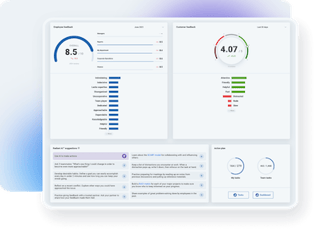
How Employee Engagement Surveys Limit Potential by Ignoring the Individual
“With unemployment at 4% and 71% of employees saying they're open to leaving their jobs, employee engagement has become a strategic imperative for leaders,” says Susan Hunt Stevens with Forbes Boston Business Council.
If it’s clear that employee engagement is important, and leaders are motivated to measure and improve employee engagement, why aren’t more of them seeing an impact?
The global survey
Standard surveys offer a global approach to employee engagement. They look for a uniform experience that applies to all employees and build questions around that experience. If every employee has benefits and a workspace, you’re likely to get plenty of responses by asking “Are you happy with benefits?” and “Are you happy with your workspace and tools?”
There’s nothing wrong with asking these questions. You should ask these questions. If most of your workforce is unhappy with benefits, you should know. These types of surveys can justify investments in new benefits, recognition programs, and other global engagement initiatives.
But these benefits drop off a cliff when you try to apply global survey results to local groups.
Let’s say 70% of the company is highly satisfied with benefits, but only 30% of your team is satisfied. What can you do? As manager, do you have the power to change your team’s benefits? Probably not. Is the company going to change a benefits policy that’s working for the majority of employees so your team can be more engaged? Probably not.
The problem with deploying a global survey is that it only works at the global level. Addressing the needs of the majority won’t help every team, let alone every individual, feel more engaged.
Another issue with deploying a global survey is that you'll be forced to act on global trends.
If 60% of the company is satisfied with leadership decisions, and that number falls to 58%, do you take action, or do you leave it alone? What company-wide action could you justify based on a 2% decline? What if it falls to 55%? How do you decide how much your scores have to decline before calling it a problem and investing resources?
You could look at trends at the team level, which would give you a better idea of what specific groups need to address specific problems. But then you’re relying on global survey questions, that by nature have to be general enough to inspire high completion rates, to identify local trends. A team manager has no more insight on a 2% change on his overall decision-making than a CEO.
The problem with the global approach is that it only works for global scenarios. It misses the opportunity to effectively address local scenarios that affect engagement, leaving many individuals with unmet needs.
Why you need to address individuals
Research consistently shows us what drives employee engagement: positive manager relationships, recognition, and professional development are just a few drivers that be evaluated and addressed locally for individuals. However, local scenarios that affect engagement are intimidating because they get into specifics about individual employees. It’s much easier to say, “Leadership needs to work on listening more,” than, “Tim, most of your team thinks you’re a poor listener.” But which is going to be more helpful to Tim and his team?
The reality is: individuals affect engagement, and individuals in management positions strongly affect engagement. If you don’t embrace this and act on engagement at the individual level, you miss out in the following ways:
- People who limit engagement won’t be able to improve.
- People who build up engagement won’t be recognized or encouraged.
Engagement isn’t based on one factor or rooted in a single scenario- it’s a culmination of feelings and experiences from all aspects of work, including coworkers. Giving individuals the power to share the personal experiences that impact their engagement benefits everyone in the company. Individuals see that their experiences matter, and they can learn and grow professionally from the experiences of others.
How Macorva improves engagement
We designed the Macorva engagement survey to employ a global and local approach to engagement so leaders can be empowered to meet the needs of the organization and the individual.
With our AI-powered surveys, employees are asked essential global questions to measure overall engagement and given a chance to provide feedback as open comments. Once these global results are submitted, employees are asked to anonymously rate their experiences with coworkers on a 1-5 scale, with optional attributes like “Reliable” or “Disorganized” available for additional feedback. Employees can rate their experiences with anyone in the company and effectively share their unrestricted experiences at work.
Macorva does not share direct ratings- feedback is returned to individuals as scores represented from all coworker impressions. Scores are weighted out of 10 and only displayed when 5+ impressions are provided. This secures anonymity and ensures individuals get actionable results.
While empowering to the individual, this approach also yields results that are ultimately more useful to the individual than global surveys alone. Every employee receives an Overall feedback score, plus a breakdown of scores from those Above (managers), Below (direct and indirect reports), Inside (same department), and Outside (different department).
This gives every employee feedback to guide their professional development, a consistent driver of engagement, by assessing their esteem with different groups in the organization and reporting consistent feedback from coworkers. To keep feedback constructive, attributes are only displayed when included in a large percentage of impressions.
In addition to returning valuable feedback to employees, Macorva’s results also identify scenarios linked to engagement outcomes so they can be addressed at the individual level. Managers that hold high esteem with their teams can be recognized and made into mentors. Managers that struggle with their teams can be coached. “Silent superstars” with high esteem, but low upward visibility, can be put on management’s radar.
By recognizing and embracing the impact individual employees have on company engagement, we offer an unprecedented ability to address engagement at the individual level. We give managers powerful starting points for conversations that will make good employees great, and great employees excellent. We provide the tool that finally goes beyond measuring engagement and provides meaningful data to improve it.




